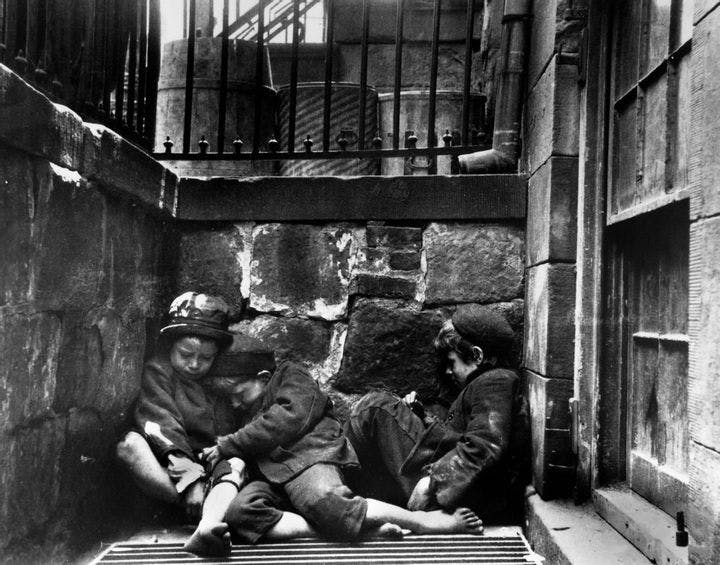Fall 2008
Poverty of the Imagination
– James McGrath Morris
James McGrath Morris reviews a chronicle of Jacob Riis's rise from poor immigrant to famous muckraker.
More than a century has passed since the publication of How the Other Half Lives, Jacob Riis’s portrait of poverty that shamed America. The effect of the book, which is still in print, was as profound as that of Harriet Beecher Stowe’s Uncle Tom’s Cabin. Yet until now, Riis has been without a decent biography.
The Other Half is a comprehensive account of the Danish immigrant who became the Tocqueville of America’s underclass. Using material passed over by others, such as Riis’s diaries, written in Danish and gathering dust in the New York Public Library, Tom Buk-Swienty amply portrays Riis’s storybook life and his role in publicizing the horrors of Gilded Age poverty.
Born in a small town in Denmark in 1849, Riis made his way to the United States in 1870 after failing to win the hand of a local beauty. Remarkably, and Hollywood-like, Riis found financial success in the United States, after much hardship, and got the girl six years later.
It was as a New York City police reporter that Riis began the work for which he would become known. Few, if any, reporters possessed the temerity of Riis, who made it a habit to wander the streets and alleys of the Lower East Side, especially at night. It was almost as if a new and dangerous frontier were opening in the burgeoning urban landscape of America just as the fabled one in the West was closing. And, like an industrial-age Meriwether Lewis, Riis explored it.
For a decade, he worked to awaken his readers to the privation that lay in the dozen square miles of dilapidated tenements only a few blocks from the city’s prosperous avenues. Riis wrote about children dying from epidemic outbreaks of diptheria, sleeping men falling to their deaths from roofs where they had sought refuge at night from the stifling summer heat, blind beggars living in hovels, and armies of tramps moving through the streets. But his dramatic newspaper accounts failed to stir the public to act.
In the late 1880s, technology offered Riis a new way to reach his audience. Armed with a hand-held camera and a revolutionary flash powder, he retraced his journeys through the Lower East Side. The photographs with which he returned have since become iconic images known to all, from schoolchildren thumbing through textbooks to scholars of American history. By combining graphic representations of poverty with anecdotal tales that humanized the victims and were buttressed with “scientific” statistics, Riis established a new kind of American journalism. The emotionally powerful formula, well suited to the emerging mass media, stoked newspaper circulations and fanned the flames of reform.
At the time, permanent poverty was an unthinkable social ill in the United States. Many in the comfortable classes believed that the worst poverty was confined to a few newcomers who would eventually join the middle class through hard work and frugality, as generations before had done. Those who remained poor did so because of their own failings. Riis’s work brought this Jericho Wall of smug reasoning tumbling down. After the publication of How the Other Half Lives in 1890, it became broadly accepted that the poor were victims of circumstances, an idea that laid the groundwork for 20th-century efforts to combat poverty.
In this biography, Buk-Swienty, a Danish journalist, chronicles Riis’s rise from poor immigrant to famous muckraker. But in doing so, the author condenses the remaining third of his subject’s life to a scant 40 pages, implying that Riis rode off into the sunset like a Lone Ranger of social justice whose work was done. In fact, the remaining years until his death in 1914 were productive: Riis wrote a dozen more books and finally possessed the power and influence—with friends such as Theodore Roosevelt—to make headway in ending the poverty he recorded.
This part of Riis’s saga is as important as his rise, for it reveals the limits of muckraking. Riis managed to change some housing laws and raze some of the worst tenements, but beyond those small victories, he found it was one thing to provoke shame in his adopted land but another to bring about true and lasting social change.
* * *
James McGrath Morris, the author of The Rose Man of Sing Sing and Jailhouse Journalism, is at work on a biography of Joseph Pulitzer. He edits the monthly newsletter The Biographer’s Craft.
Reviewed: The Other Half: The Life of Jacob Riis and the World of Immigrant America by Tom Buk-Swienty, translated by Annette Buk-Swienty, Norton, 331 pp, 2008.
Photo courtesy of Wikimedia Commons
